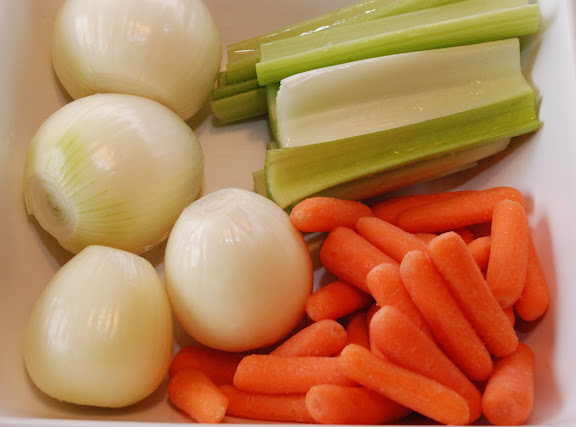* Mise en place
* Mirepoix
* Knife skills and different kinds of cuts
Mise en place (meez-on-plahs) means “set in place”, getting everything for a recipe ready beforehand, including preparing any vegetables, measuring out liquids and dry ingredients, and assembling the equipment you will need.
Mirepoix (MEER-pwah) is a basic flavouring for soups and stews according to Le Cordon Bleu Complete Cooking Techniques (affiliate link) comprised of a coarsely diced mixture of onions (or leeks), carrots, and celery. Roughly half the mixture is onions, a quarter is carrots, and another quarter is celery.

A knife is the most important tool in the kitchen, and therefore knife skills are one of the most important skills a chef can learn. With proper technique, accomplished chefs can quickly cut through mounds of vegetables quickly and efficiently. That’s not me! I’m still learning. I have been enjoying learning from the latest handbook about knives called Knife Skills Illustrated (affiliate link) by Peter Hertzmann. Here is a list of the different types of cuts, their sizes, and a picture:
Large dice
¾ inch cube
2cm cube
 Medium dice
Medium dice½ inch cube
1cm cube
 Small dice
Small dice¼ inch cube
6mm cube
 Brunoise (BREWN-wahz)
Brunoise (BREWN-wahz)between 3/16 and ⅛ inch cube
2-3mm cube
 Fine Brunoise
Fine Brunoisefinely diced cube
1/16 inch cube
1.5mm cube
 Paysanne (PAHY-sahn)
Paysanne (PAHY-sahn)flat square or triangle
½ inch by ½ inch by ¼ inch
1.2cm by 1.2cm by 6mm
To cut a paysanne, take one of the dices and cut it in half.
Bâtonnet (BAH-toh-nah)
matchstick shape
¼ inch by ¼ inch by 2-2½ inches
6mm by 6mm by 5-6cm

Julienne (JU-lee-en)
long, thin sticks, sometimes called matchsticks
⅛ inch by ⅛ inch by 1-2 inches
3mm by 3mm by 2.5-5cm

More to Explore:









0 comments:
Post a Comment